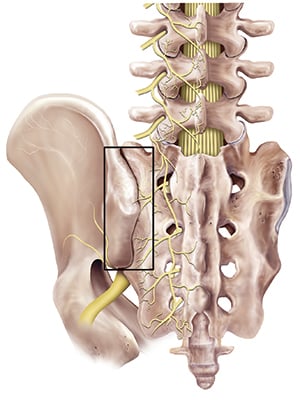Sacroiliac Joints
Women are more likely than men to get SIJ pain. The SIJ’s can be a source of pain for a number of reasons.
Trauma: such as through normal childbirth, or a traction or compression type injury; for example, with a road traffic accident or fall.
Degenerative changes: which can be age related, or sometimes linked to more load through the SIJ, such as when the low back joints have been fused.
Inflammatory conditions: that can sometimes affect the joints in the spine, called spondyloarthropathies. These include conditions such as Psoriatic Arthritis and Ankylosing Spondylitis. Less commonly other inflammatory conditions such as Crohn’s Disease and Ulcerative Colitis can also be linked to spondyloarthropathy.
At New Hall our spinal specialist team commonly assess and treat SIJ pain and dysfunction and are experienced in recognising symptoms. There are a specific set of tests that can be done to assess the SIJ and after taking a careful medical history there are often clues that will raise suspicion that the SIJ might be responsible for symptoms.

Medications
Early pain relief is essential as sacroiliac joint dysfunction can be very painful. It is common for function to be limited and for sleep to be restricted, particularly when trying to turn over in bed. Most pain medications reduce symptoms, but do not eliminate them entirely. If you have some pain relief the evidence suggests you move better, sleep better and therefore recover more quickly. Talk to your GP about a suitable prescription based on your other medical history. The National Institute for Clinical excellence (NICE) recommend anti-inflammatories for sacroiliac pain. It There are other pain relieving drugs that your GP can prescribe if anti-inflammatories are not suitable or do not give sufficient symptom control for you.
Physiotherapy
Manual therapy, particularly manipulation, has been shown to help people recover from sacroiliac joint (SIJ) pain and dysfunction. At New Hall Hospital we have a Physiotherapy department and offer rapid access clinics. By knowing the right way to exercise and manage flare ups of pain you are more likely to be able to manage any episodes if they occur. If you are physically fit then you are less likely to suffer with recurrent episodes.
Investigations
Blood tests can be helpful to explore whether there may be an underlying inflammatory condition causing SIJ pain. Raised inflammatory markers or a specific test for a gene called HLAB27 can raise suspicion for inflammatory conditions that affect spinal joints, however these findings can be found in people without symptoms, so have to be carefully considered alongside other symptoms and tests. If an underlying inflammatory or autoimmune condition is suspected following blood tests that you have not already had diagnosed, then a referral can be made from New Hall to a Rheumatologist, who specialises in the medical management of these conditions.
X-Rays of the SI joints and spine can be helpful in conjunction with other examination findings, but often do not show any changes in early SIJ problems so can be falsely reassuring. Magnetic Resonance Imaging (MRI) with specific sequences to pick up inflammatory or degenerative changes can help, but do not always show changes. It is important to stop taking any anti-inflammatory medicine two weeks before a scan as this medication can reduce the inflammatory changes we are looking for on a MRI scan.
If you have Private Insurance or wish to Self Pay, then New Hall offers rapid access Spinal Consultant appointments with fast access to MRI scan then review of these images to consider treatment options.
Sacroiliac Joint Diagnostic Injection
If you have ongoing sacroiliac joint (SIJ) pain despite medication and manual therapy, then there are other orthopaedic treatment options that can sometimes be suitable. In order to confirm whether or not the SIJ is responsible for your symptoms a local anaesthetic (block) can be injected around the nerves that supply the joint. This Sacroiliac block is a simple procedure that can be done under x-ray guidance at New Hall Hospital. If you experience a change in symptoms while the local anaesthetic is working, then you may be eligible for either SIJ Rhizolysis or SIJ Fusion.
Rhizolysis/Radio frequency Lesioning
If you noticed a change in your symptoms following a SIJ Block Injection, then you could be a candidate for Rhizolysis, which is also called radiofrequency denervation (RF). This is a procedure where the tip of a specially designed needle is heated using radiofrequency waves in order to deliberately damage the nerves carrying pain signals from the SIJ. It can give longer lasting pain relief than the SIJ block, but sometimes the nerves that supply the SIJ grow back to resupply the joint, therefore symptoms can return. It is a low risk procedure that can be done under local anaesthetic as a day case procedure at New Hall.
Sacroiliac Joint (SIJ) Surgery
At New Hall Hospital a number of our Consultant Spinal Orthopedic Surgeons ; Mr Hilton, Mr Davies, Mr Chapple use the iFUSE system to fuse the SIJ with a minimally invasive technique. iFuse has been approved by the National Institute for Clinical Excellence (NICE) for use in selected patients with sacroiliac joint dysfunction/pain who have had a diagnostic reduction in their symptoms with a SIJ Block Injection. A small incision around two to three inches long, is made along the side of the buttock. The Surgeon uses fluoroscopic X-Rays to place a specially designed guidance system across the joint in several places. Depending on the shape and size of your joint and your bone quality, typically, two or three implants are used. The triangle shaped implants are placed across the joint following the guidance system. They are made of titanium and have a roughened surface with holes along the length of the implant, which encourage your own bone to grow into and across the implant to strengthen the fusion. There is usually no need for additional screws.
If your specialist and you feel that having discussed the risks and complications of an operation, you would like to proceed they will guide you through the process to consent to the surgery and to be evaluated by our Pre-Operative Assessment Team (POA). New Hall Hospital offers fast access surgery for both patients wanting to Self Pay and those who have Private Medical Insurance. We also see large numbers of NHS patients.
The following patient information leaflet, written by SI Bone, the manufacturers of iFuse outlines risks and complications of surgery as well as frequently asked questions.
iFuse Implant System - view here
iFuise Implant System Risks - view here


